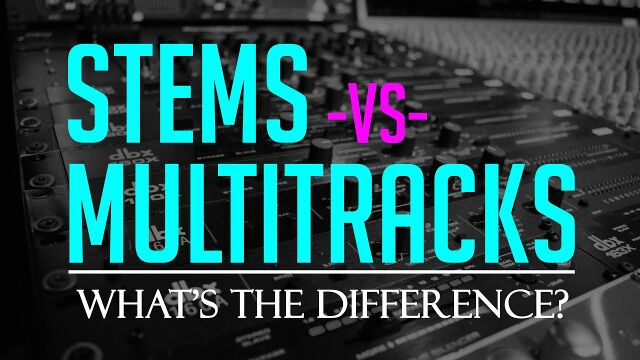Stems vs Multitracks
From MusicTechWiki
Overview
Multitracks are great for mix practice and studying music production techniques.
There are lots of words that have established meanings in the music-making community — some terms that go back decades. As newcomers enter the fray, frequently there is confusion about what those terms mean. Here’s one example that has been discussed quite frequently, so I thought I’d set the record straight.
This has been a troublesome issue for mixers. It was recently highlighted by one of our industry’s luminaries, legendary mixer Bob Clearmountain, who posted on Instagram trying to clarify.
“Hi guys. I wanna talk about something that’s been kinda bugging me lately. I hear a lot of people referring to original multitrack files as ‘stems.’ I hear that all the time. ‘Well, we’re going to send you the stems to mix.’ Well, I usually don’t mix from stems. Stems are actually subgroups of tracks, like you might have a stereo stem of a drum set or a stereo stem of all the guitars or all the keyboards. Original multitracks with everything separate, with all the drums on separate channels, those are not called stems. And a lot of people call them that these days, and it’s just wrong . . .”
I want to hop on that bandwagon, too, because this has been a source of confusion for clients for many years.
What’s the difference between stems and multitracks? It’s simple.
What are multitracks?
Multitracks are the individual recorded elements of a song, and may be stereo or mono. Using a four-piece rock band as an example, the recording engineer miked the kick, snare, hi-hat, overheads, vocals, guitars and bass. Each of these recorded signals comprises a separate track. All of them together are a multitrack audio production.
Multitracks are often unprocessed to give the mixing engineer the greatest amount of flexibility when it comes time to put the puzzle together. Often they have very little EQ, compression and time-based effects that come into play during the mixing stage.

What are stems?
Stems are great to listen to what effects and signal processing the mix engineer used on different instruments and vocals.
Stem mixing and mastering - Wikipedia
Multitracks differ from stems. Stems are stereo bounces of pre-mixed elements. For instance, a drum stem would be a single stereo track of the entire recorded kit. While stems are useful for consolidating pre-mixed elements in a large session, they’re not of the greatest use when it comes to practicing our mixing skills. This is because a mixing engineer already committed to signal processing choices and printed his or her tracks as a stem.
The ability to individually manipulate the kick, snare, hi-hat, etc., with multitracks is where we really learn what we’re doing. Sessions comprised solely of stems are typically created after the entire mixing process.
Stems are stereo submixes of components within a mix. This started years ago (even before the dawn of the DAW age), when we would print the finished MASTER mix for duplication (like on physical media such as vinyl, cassette, or CD — I know, I’m old). Then we’d print an INSTRUMENTAL mix (INST — instruments only with no vocals), a TV TRACK (full mix minus the lead vocal for use on TV shows when the artist is performing without a band, hence the name), and a VOX ONLY mix (lead vocal plus background vocals with no instruments). If you combined the INST mix with the VOX ONLY mix, then you could re-create the master, but the balance between the two (instruments and vocals) could be adjusted in mastering if necessary.
Once the labels discovered they could adjust volumes without going back for a remix, they began requesting INST only, BGVs only, and LEAD VOC only so they could balance those components in post. All these stereo submixes would have all the processing and reverb from the original mix but with certain elements missing (what is called “Mix Minus”). Then someone realized you could do the same with certain other instruments, as well, and have control after the fact.
Fast-forward to the early 21st century, and things got really crazy. For orchestral remixes, I might routinely print as many as 17 “stem” mixes (stereo submixes) of components, breaking it all the way down to the elements such as I list below. This allowed the labels to go back and make adjustments after the fact without engaging (or paying) the original mix engineer. Plus, they could use the stems to make gaming, performance, or practice tracks to sell — another revenue stream. (Nothing wrong with additional revenue streams, right?)
Here’s what stem mixes might look like for a single song.
- DRUMS
- BASS
- GTRS
- KEYS
- PIANO
- PERC LOOPS
- LEAD VOC
- BGVS
- STRINGS
- WOODWINDS
- BRASS
- HORNS
- ORCH_PERC
- HARP
Multitracks
When the original recording is done, individual tracks are designated for individual instruments. These may (or may not) include processing (EQ, compression, effects) on the individual parts, depending on the tracking engineer’s preference or skill level. When delivering multitracks for an overdub or mix session, the track listing will typically look like the following:
- Kick
- Snare_Over
- Snare_Under
- HiHat
- Tom1
- Tom2
- Tom3
- Overhead_L
- Overhead_R
- DrumRoom_L
- DrumRoom_R
- Piano_Lo
- Piano_Hi
- Keys_L
- Keys_R
- Bass_Dir
- Bass_Amp
- AcGtr
- AcGtr_Double
- ElecGtr_1
- ElecGtr_2
- Lead Vocal
- BGV 1
- BGV 2
- BGV 3 . . .
- BGV 4
- and so on.
When you deliver the multitracks to a mix engineer, you want to make sure they have the original files to work with. You do not want to send a mixer just the stems with all the processing, balances, and compression already applied because then you are tying their hands and not allowing them the flexibility to do their job.